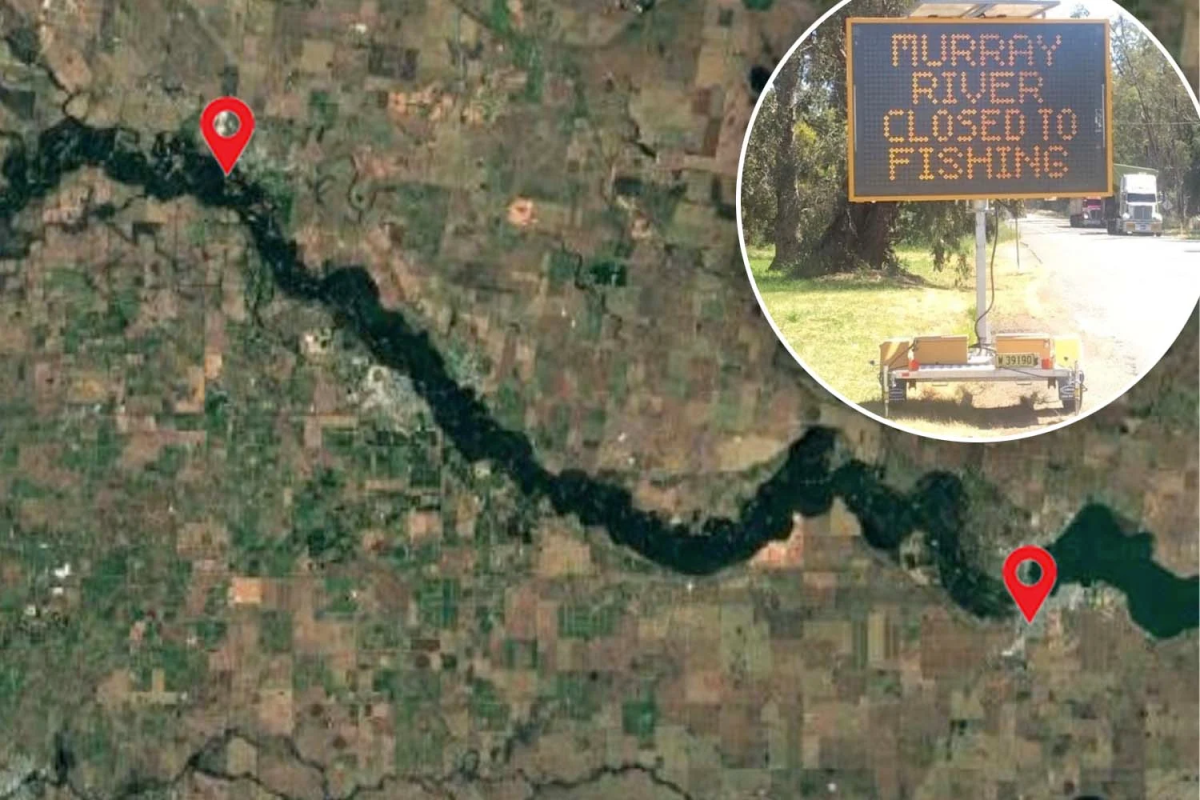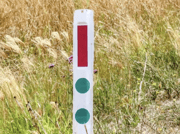
The Murray River holds a secret few anglers ever seen.
For a short window each year, a rare species fights to survive against the odds.
Disturbing its habitat could risk the last chance for a miracle in the wild.
Protecting the last wild trout cod
Between Yarrawonga and Tocumwal, a 101-kilometre stretch of the Murray River has been closed to all fishing this year, not as a bureaucratic formality, but to protect the final natural breeding ground of one of Australia’s rarest native fish.
Trout cod, a species formally recognised in 1972, once swam throughout the southern Murray-Darling Basin but faced catastrophic declines in the 1970s, leaving only three self-sustaining populations before the mid-2000s.
Today, the largest remaining wild population occupies approximately 200 kilometres of river between Yarrawonga and Barmah.
'With close to 50,000 fingerlings bred at Narrandera Fisheries Centre in 2024, triple the number produced in 2023, we are well on the way to achieving the goal of 250,000 bred annually.'
The closure from September to November coincides with the trout cod’s spawning season, when adults reach sexual maturity at 3-5 years and deposit between 1,200 to 11,000 eggs on hard surfaces such as logs and rocks.
These large, adhesive eggs hatch after 5-10 days, with larvae drifting downstream, making any disturbance—even catch and release fishing—potentially fatal for the species’ future.
Amazing trout cod facts
Amazing trout cod facts
Can grow up to 40kg, making them one of Australia's largest freshwater fish
Were once confused with Murray cod until formally recognised as separate in 1972
Live in deeper pools near logs and boulders in faster-flowing water
Are most active during low light hours from dusk to dawn
Have high site fidelity, often staying within 500 metres of a 'home snag'
Conservation programs giving hope
Recent conservation efforts have brought renewed hope.
In 2024, 47,000 fingerlings were bred at Narrandera Fisheries Centre and released into Snowy region waterways, with the government targeting 100,000 fingerlings per year and aiming to reach 250,000 within 5-10 years.
Innovative pond spawning techniques have improved breeding success, offering a gentler and more productive alternative to hormone induction, signalling a remarkable turnaround for a species once teetering on the edge of extinction.
For visitors planning a Murray River trip, the closure means fishing must take place outside the protected zone that runs from Yarrawonga Weir Wall to the Newell Highway Road Bridge at Tocumwal.
Penalties are serious, reflecting the species’ endangered status: on-the-spot fines start at $500, with court proceedings potentially reaching $22,000.
Trout cod are listed as endangered under both Commonwealth and state legislation, as well as by the World Conservation Union and the Australian Society for Fish Biology.
Long-term protection and research
The Murray River’s seasonal protection has been in place for over 30 years, highlighting Australia’s long-term commitment to native species recovery.
Research has shown that trout cod growth is optimised by variable environmental flow regimes, with stable low-flow periods, such as the Millennium Drought, reducing growth rates.
Temporary signage reminds visitors of the closure, and illegal fishing can be reported through Fishers Watch on 1800 043 536.
Essential closure information
- Area: 101km from Yarrawonga Weir Wall to Newell Highway Road Bridge at Tocumwal
- Duration: September to November annually (over 30 years running)
- All fishing prohibited: Including catch and release
- Fines: $500 on-the-spot, up to $22,000 in court
- Reporting: Call 1800 043 536 for illegal fishing
- Purpose: Protecting the last wild trout cod population during spawning
A hopeful future for trout cod
Conservation success is tangible.
Fingerlings are being released into habitats within the species’ historical range that feature pristine conditions, including rocks and fast-flowing water, offering hope that trout cod could one day return to rivers from which they vanished decades ago.
Your patience with this temporary inconvenience plays a direct role in one of Australia's most important conservation success stories.
What This Means For You
The Murray River stretch from Yarrawonga to Tocumwal is closed each year from September to November to protect the last wild trout cod breeding ground.
This endangered species has only one natural population remaining, making them extremely sensitive during their spawning period.
Conservation programs, including breeding and innovative pond spawning methods, are increasing fingerling numbers and offering genuine hope for the species’ recovery.
Authorities take this protection seriously—violating fishing restrictions can result in fines up to $22,000, highlighting the critical conservation status of these remarkable fish.
For visitors, especially retirees who often enjoy Murray River fishing, this temporary closure is a small but vital step in ensuring that future generations can witness trout cod thriving in their natural habitat.
By planning trips outside the protected zone and respecting the rules, you directly contribute to one of Australia’s most important conservation success stories.
Warning over $22,000 fine for fishing in 100km stretch of popular Aussie river — Reports on the Murray River closure to protect the last wild trout cod breeding ground and the associated penalties for fishing during spawning season.
https://au.news.yahoo.com/warning-o...tretch-of-popular-aussie-river-204836432.html
National Recovery Plan for the Trout Cod—Maccullochella macquariensis—DCCEEW — Details the catastrophic decline of trout cod and notes that only one natural population remains in the wild.
https://www.dcceew.gov.au/environme...y-plan-trout-cod-maccullochella-macquariensis
Trout cod—Maccullochella macquariensis — Provides background on the species’ formal recognition in 1972 and its biology.
https://www.mdb.fish/fish-fact-sheets/trout-cod
Trout cod—Maccullochella macquariensis — Covers the historical range of the species and its decline to only three self-sustaining populations before the mid-2000s.
https://www.mdb.fish/fish-fact-sheets/trout-cod
Trout cod—Maccullochella macquariensis — Describes the largest remaining population between Yarrawonga and Barmah, spanning approximately 200 kilometres of river.
https://www.mdb.fish/fish-fact-sheets/trout-cod
Trout cod—Maccullochella macquariensis — Notes sexual maturity at 3–5 years and spawning in late spring, with eggs deposited on hard surfaces.
[URL='https://www.mdb.fish/fish-fact-sheets/trout-cod[/URL']https://www.mdb.fish/fish-fact-sheets/trout-cod[/URL]
Trout cod—Maccullochella macquariensis — Reports on egg fecundity of 1,200–11,000 per female and their adhesive nature.
[URL='https://www.mdb.fish/fish-fact-sheets/trout-cod[/URL']https://www.mdb.fish/fish-fact-sheets/trout-cod[/URL]
Trout cod—Maccullochella macquariensis — Explains larval development and downstream drift after hatching.
https://www.mdb.fish/fish-fact-sheets/trout-cod
Threatened native Trout Cod recovery underway with innovative fish breeding & stocking — Highlights breeding programs at Narrandera Fisheries Centre and government targets for fingerling releases.
https://www.dpi.nsw.gov.au/about-us...ay-with-innovative-fish-breeding-and-stocking
Threatened native Trout Cod recovery underway with innovative fish breeding & stocking — Describes innovative pond spawning techniques improving breeding success.
https://www.dpi.nsw.gov.au/about-us...ay-with-innovative-fish-breeding-and-stocking
Trout cod recovery plan — Confirms endangered status under Commonwealth and state legislation and other conservation listings.
https://www.dpi.nsw.gov.au/fishing/...rvation/what/recovery/trout-cod-recovery-plan
Trout cod—Maccullochella macquariensis — Research shows growth is best supported by variable environmental flow regimes, with lower growth during stable low-flow periods.
https://www.mdb.fish/fish-fact-sheets/trout-cod
Threatened native Trout Cod recovery underway with innovative fish breeding & stocking — Conservation stocking focuses on pristine habitats within the species’ historical range.
https://www.dpi.nsw.gov.au/about-us...ay-with-innovative-fish-breeding-and-stocking
The story of the trout cod highlights how fragile some fish populations are and why careful protection matters.
If you found this fascinating, there’s another incredible example of a rare fish species facing unique challenges in the wild.
This next article dives into a bizarre discovery that has serious implications for conservation and ecosystem management.
Read more: Scientists Unveil Bizarre Australian Fish Secret You Won't Believe - See Why It's a Game Changer!
What are your thoughts on balancing recreational fishing with native species conservation?







